[/caption]
Assembly of NASA’s first Orion Crew vehicle that could actually launch to space has been accomplished by prime contractor Lockheed Martin Corporation at the firm’s Waterton space systems facility located near Denver, Colorado, where the spacecraft is slated to begin a severe testing process that will help confirm crew safety.
Orion is NASA’s next generation spacecraft designed to send human crews to low Earth Orbit and beyond to multiple deep space destinations throughout our solar system including the Moon, Mars and Asteroids. Orion was recently recast as the MPCV or Multi Purpose Crew Vehicle in the NASA Authorization Act of 2010.
“The first Orion crew module built to spaceflight specifications is complete,” said Linda Singleton, a spokesperson for Lockheed Martin in an interview.
“Orion will soon be integrated with the launch abort system test article prior to undergoing acoustic, vibration and modal testing in Denver,” Singleton told me. “The testing process will last several months.”
Watch this cool and detailed animation of the testing process to be conducted at the Reverberant Acoustic Lab at Lockheed Martin’s Waterton Facility.
The video also shows how the Orion will be integrated and tested with the Launch Abort System (LAS) that would save the lives of the astronauts on board in the event of a spaceflight emergency.
With the Grand Finale of NASA’s Space Shuttle Program now just days away after the launch of shuttle Atlantis on the STS-135 mission, the US faces a gap with no capability to send humans to space and the International Space Station for a time period extending at least several years.
A replacement vehicle for the retiring shuttle – whether its the Orion or from a commercial provider like SpaceX – can’t come soon enough in order to maintain the viability of the International Space Station.
This Orion vehicle also known as the Ground Test Article, or GTA, will now be subjected to several months of rigorous flight like testing that simulates the harsh environments that astronauts would face during voyages to deep space.
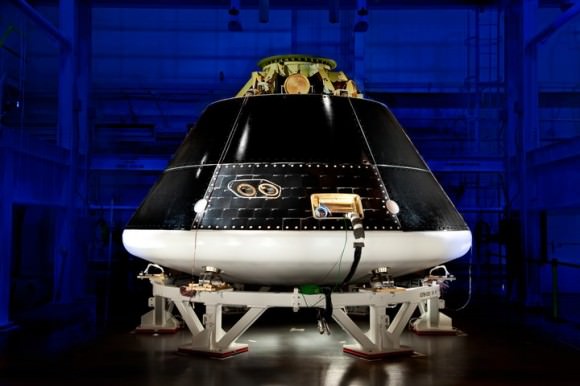
The Orion MPVC Multi Purpose Crew Vehicle ground test article (GTA) is shown at the Lockheed Martin Vertical Test Facility in Colorado. The GTA’s heat shield and thermal protection backshell was completed in preparation for environmental testing. Credit: NASA/Lockheed Martin
Thereafter, the Orion crew module will be transported in early 2012 to NASA’s Langley Research Center in Virginia where it will undergo water landing drop tests next year at the new Hydro Impact Basin facility.
“The NASA and Lockheed Martin teams hope to achieve Orion/MPCV initial crewed operations by 2016”, said Singleton. “We are aiming for an initial unmanned orbital test flight in 2013.”
A Delta IV Heavy booster rocket is the most likely candidate for the 2013 Orion orbital flight, but a final decision has not yet been announced by NASA.
Meanwhile, another Orion crew module that was flown during the Pad Abort 1 test (PA-1) in 2010 is now on public display at the Kennedy Space Center Visitor Complex in Florida. The vehicle just arrived after a cross country trek from NASA’s Dryden Flight Research Center in California and making several public outreach stops along the way to Florida.
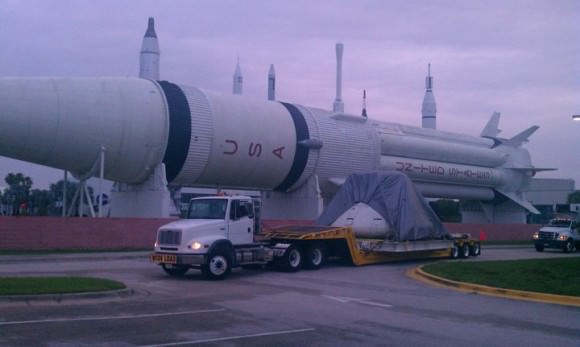
The Orion PA-1 test article is on display until July 4 in the historic Rocket Garden at Kennedy in the shadow of a mighty Saturn 1B and alongside Mercury, Gemini and Apollo Era capsules and rockets. The mockup of the LAS is also still on display at the Kennedy Visitor Complex.
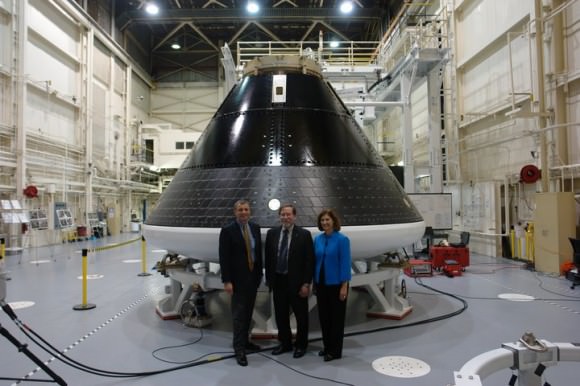
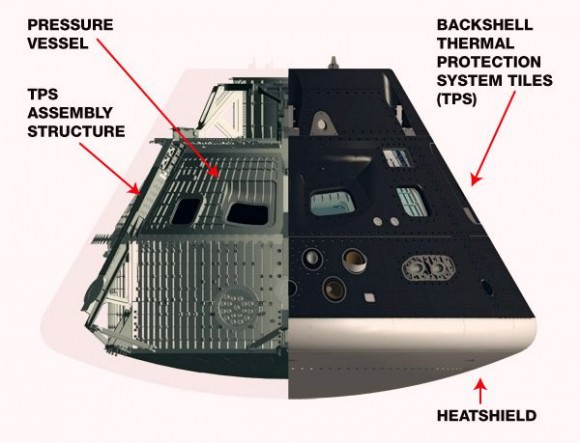

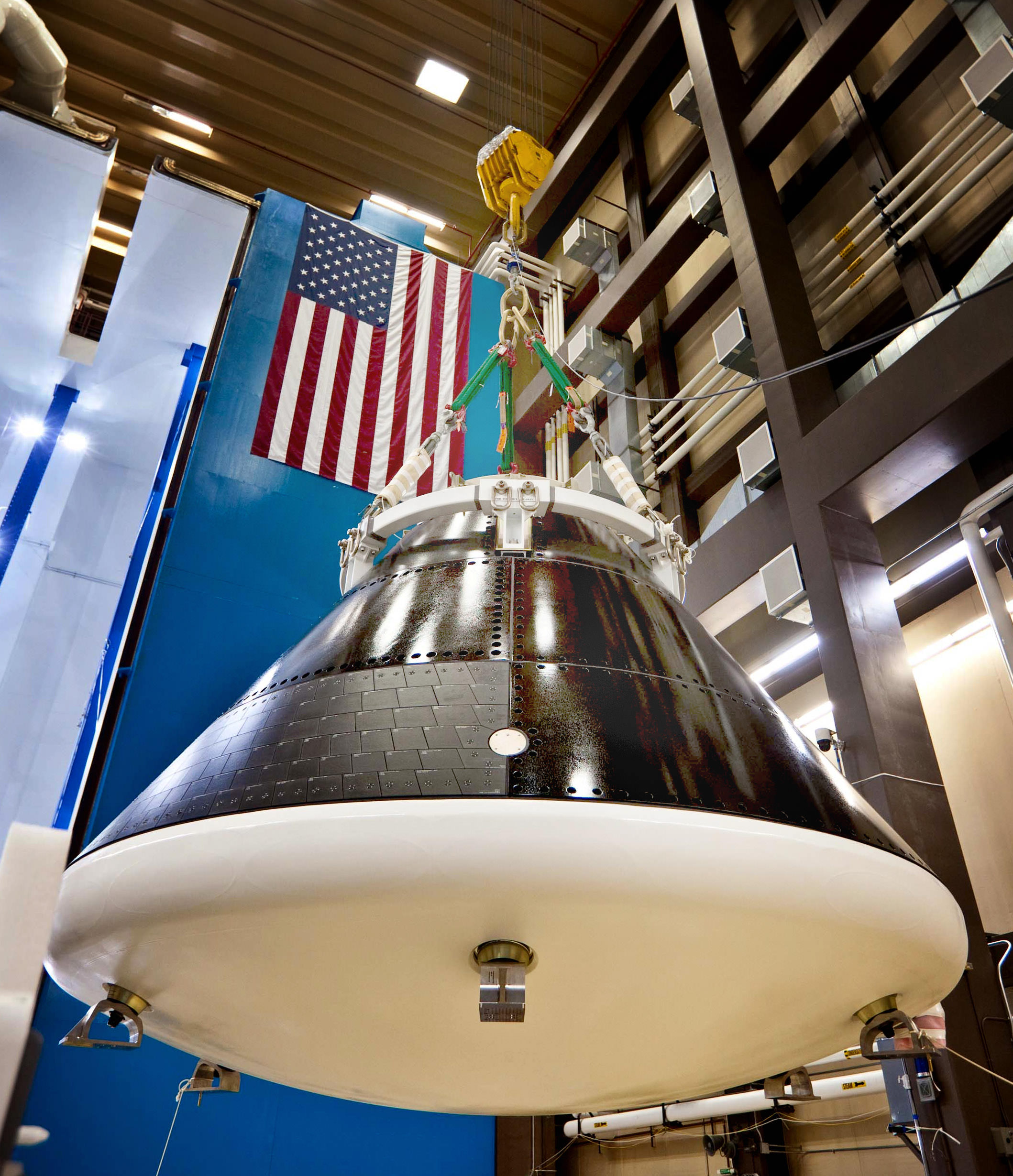
With all the interest in nostalgia and certain members of Congress wanting so desperately to return to the “good ol’ days,” it’s nice to see us going back to the past to reinvent technology that was outdated in the sixties instead of working on new space planes launched from, say, mag-lev tracks built up the side of a mountain, moon ships launched from equatorial orbit from construction/re-fueling stations or lunar colonies that would teach us how to actually live self sufficiently in a vacuum for extended periods of time. Doc Brown would be proud.
I couldn’t agree more, but it’s not our grandads NASA anymore, it’s just another government run agency that performs in a very much less than stellar fashion. Again we get the best “government” money can buy, and in the end, we lose out. The least they could’ve done was bring back the Saturn V rocket! The origianl “muscle car” of the space race!
It’s no space plane (the STS wasn’t much of one either), but I prefer a man-rated vehicle featuring a launch escape system and a heat shield that can’t be killed by a chunk of styrofoam.
Space x has done the Saturn V one better. More lift, more efficient motors, cheaper launch, better materials, lighter-faster- stronger(music please) electronics…….His bird is a real powerhouse.
Space x has done the Saturn V one better. More lift, more efficient motors, cheaper launch, better materials, lighter-faster- stronger(music please) electronics…….His bird is a real powerhouse.
Yeah…… the Saturn V was an absolute beast. People that saw it launch in person have told me it would literally pound away at your chest and send staccato shock waves through the ground……. even when you were standing several miles away from the pad!!!!!
Better to stay in space with proven gear than be sitting on the ground with great ideas. To much has been barely possible for too long. Willi Ley wanted a space DC3, I’d be thrilled if we could manage a space JU 52.
I’ve flown in a JU52 in Africa. It’s a damned reliable aircraft and a lot tougher than the DC3.
In 1966, NASA consumed a whopping 5 percent of the federal budget. Since the early 1970’s, NASA has been given less than 1 percent of the federal budget. As long as that’s the reality of the situation, we all just better just learn to deal with it and be grateful for what we have…… if anything.
In 1966, NASA consumed a whopping 5 percent of the federal budget. But ever since the early 1970’s, NASA has only been given less than 1 percent of the federal budget……. and there’s a lot of congressmen and Tea Party people that want to cut NASA’s down even more. As long as that’s the reality of the situation, we all just better learn to deal with what we have….. whether it be “outdated” or “good ole’ days” technology and all just better learn to be grateful for ANYTHING we have right now.
This is one sexy thing.
Heh, I have the exact opposite reaction. =D
Everything from the pressure vessel, to the tile shell, to the launch shell, to the LAS system, to the service module, is ughlee. I had a similar initial reaction to Dragon. But as soon as the reason for the large docking port was explained I have come around.
The Apollo was _always_ beautiful!
Torbjörn , ugly is very subjective. With spacecraft, safety and functionality are the bywords. Besides, I disagree with your assessment; I think it is a beautiful and elegant craft. I would rather drive cross-country in an Ugly jeep (get there and back) rather than a Lexus sedan! 🙂
The current capsule designs seem to have lost the functionality of supporting EVAs first performed with Gemini 4 in June 65.
TerryG, There is clearly a docking port at the apex of the capsule, making possible docking with the ISS or another craft like the old LEM. The astronauts could even suit up and evacuate the atmosphere,store it in pressure vessels, then exit the port for an EVA. Ta Da!
Hello Skipdallas,
The Orion/MPCV surely does have a docking port (not much use without that of course), but in following NASAWatch (not a NASA website, but run by a former NASA employee with many active and retired aerospace engineers participating in the discussions), there is a comment http://nasawatch.com/archives/2011/07/last-minute-ple.html#comment-49087 which says the Orion/MPCV “does not support EVAs, does not support up or down logistics for major replacement components”. It’s safe to say the comment would have been ripped to shreds if it was incorrect. I’m just guessing the reason may run along the lines that, in the absence of an airlock, you’d need four EVA suits (or seven for the Dragon capsule) and associated infrastructure which cuts into the capsules limited interior space. But as always, I’m happy to consider a better source if someone can link to it.
Cheers (and welcome to UT – haven’t shared discussions with you b4)
Hi TerryG,
Obviously, you are plugged into information sources I have overlooked, and am unfamiliar with.My comments were made using simple logic, which I fall back upon when there is a dearth of data. Thank you for your remarks to me and the links to make your point. I do not have a technical background, but I am very interested in the Space Program, so any direction others can share is appreciated.
Speaking of which, an observation I made recently here: the Dragon supports ISS/safety better since it’s large docking port is the new standard (IIRC) and isn’t as crowded in emergencies.
I don’t know why, except money sunk, they didn’t redesign the MPCV after it was obvious its primary target isn’t Moon landings and there is little use for a minimized docking port.
For one, they will not be able to dock to other crafts than ISS I believe, neither Soyuz/Dragon/Shenzou nor Progress/ATV/HTV.
And “sexy” isn’t subjective? Have you asked your nearest turtle what he/she likes? Are you suggesting double standards? :-/
Agreed otherwise.
Hi Torbjörn , Sorry but I fail to see where “Sexy or ugly” has anything to do with a spacecraft. I commented on your post calling the Orion ugly, Olaf2 said it was sexy. Are all Scandinavians obsessed with just the cosmetic looks of a person or object? BTW I like turtles! 🙂
yeah, its cool.
There is absolutely nothing technical or logistic in MPCV that is necessary for maintaining viability of ISS. For that Soyuz for crew (3 or 6 persons) & rescue, and Progress/ATV/HTV for supply suffice. Provided enough fuel, I believe supply orbit maintenance can be maintained by Zvezda alone.
It may be that political & economical viability hang on US having or hoping to have their own crew craft, but that has never been tested. Perhaps due to sentiment like the above.